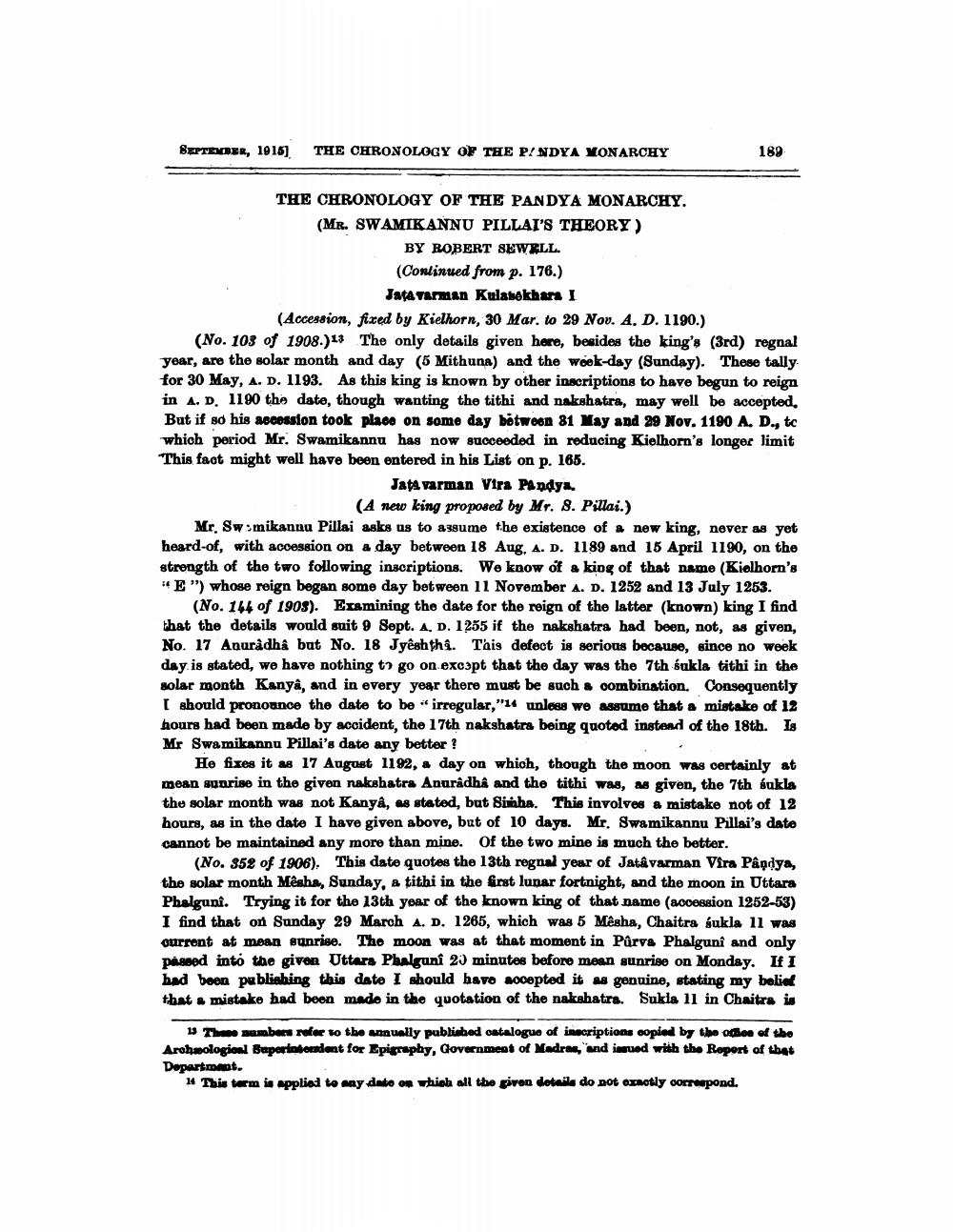________________
SEPTEMBER, 1016)
THE CHRONOLOGY OF THE PANDYA YONARCHY
189
THE CHRONOLOGY OF THE PANDYA MONARCHY. (MR. SWAMIKANNU PILLAI'S THEORY)
BY ROBERT SEWELL. (Continued from p. 176.)
Jatavarman Kulanokhara I (Accession, fixed by Kielhorn, 30 Mar. to 29 Nov. A. D. 1190.) (No. 103 of 1908.) 13 The only details given here, besides the king's (3rd) regnal year, are the solar month and day (5 Mithuna) and the week-day (Sunday). These tally for 30 May, A. D. 1193. As this king is known by other inscriptions to have begun to reign in A. D. 1190 the date, though wanting the tithi and nakshatra, may well be accepted. But if so his accossion took place on some day botweon 81 May and 29 Nov. 1190 A. D., to which period Mr. Swamikannu has now succeeded in reducing Kielhorn's longes limit This fact might well have been entered in his List on p. 165.
Jata varman Virs Pandya.
(A new king proposed by Mr. 8. Pillai.) Mr. Sw.mikannu Pillai asks us to assume the existence of a new king, never as yet heard-of, with accession on a day between 18 Aug. A. D. 1189 and 15 April 1190, on the strength of the two following inscriptions. We know of a king of that name (Kielhorn's "E") whose reign began some day between 11 November A. D. 1252 and 13 July 1253.
(No. 144 of 1903). Examining the date for the reign of the latter (known) king I find that the details would suit 9 Sept. A. D. 1255 if the nakshatra had been, not, as given, No. 17 Anuradha but No. 18 Jyêshtha. Tais defect is serious because, since no week day is stated, we have nothing to go on except that the day was the 7th sukla tithi in the solar month Kanya, and in every year there must be such a combination. Consequently I should pronounce the date to be irregular,"14 unless we assume that a mistake of 12 hours had been made by accident, the 17th nakshatra being quoted instead of the 18th. Is Mr Swamikannu Pillai's date any better?
He fixes it as 17 August 1192, a day on which, though the moon was certainly at mean sunrise in the given nakshatra Anuradha and the tithi was, as given, the 7th sukla the solar month was not Kanyâ, as stated, but Simba. This involves a mistake not of 12 hours, as in the date I have given above, but of 10 days. Mr. Swamikannu Pillai's date cannot be maintained any more than mine. Of the two mine is much the better.
(No. 352 of 1906). This date quotes the 13th regnal year of Jatâ varman Vira Pândya, the solar month Mesha, Sunday, a tithi in the first lunar fortnight, and the moon in Uttara Phalguni. Trying it for the 13th year of the known king of that name (accension 1252-53) I find that on Sunday 29 March A. D. 1265, which was 5 Mesha, Chaitra sukla 11 was ourrent at mean sunrise. The moon was at that moment in Pârva Phalgunî and only passed into the given Uttara Phalguns 20 minutes before mean sunrise on Monday. If I had been publishing this date I should have accepted it as genuine, stating my belief that mistake had been made in the quotation of the nakahatra. Sukla 11 in Chaitra is
15 The members roer to the annually published catalogue of inacriptions copied by the other of the Arshwological Baperiaheadent for Lpigraphy, Government of Madras, "and inued with the Report of that Department.
14 This term is applied to say date on which all the giron details do not exactly correspond.




